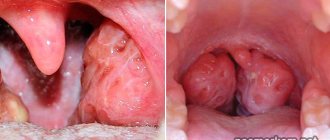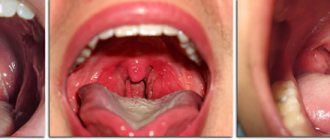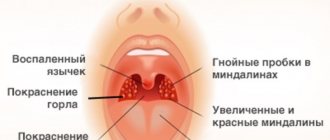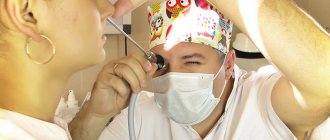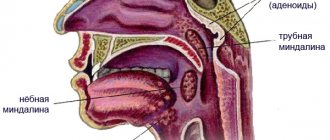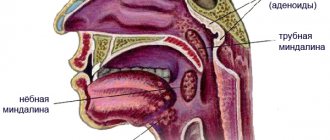If a person has a history of a diagnosis of “chronic tonsillitis,” then such a patient knows firsthand what plugs in the throat, or more precisely in the tonsils, are.
Pus plugs are one of the tonsillitis manifestations of inflammation of the tonsils. They represent an accumulation of remnants of the vital activity of bacteria and leukocytes that died in the fight against them. They also contain phosphorus, calcium and ammonia.
If you look at the palatine tonsil, its surface appears smooth. But in fact, each tonsil is permeated through and through with narrow winding canals - crypts, which end on the surface of the tonsils with openings - lacunae. It is these tortuous crypts and lacunae that become the site of bacterial dislocation and the formation of purulent accumulations. In healthy palatine tonsils, the self-cleaning function works well, which allows you to independently remove the contents of the lacunae. Inflamed tonsillitis glands cannot cope with this function. In chronic tonsillitis, plugs accumulate and cause discomfort. The medical name for tonsillitis plugs is caseous detritus. Their size usually varies from one millimeter to several centimeters. There may be several such clusters in the tonsil, but there are cases when plugs dot the entire surface of the tonsils.
About congestion in the throat
Every person has experienced pain, discomfort and a feeling of congestion in the throat many times in their lives.
This is due to the fact that a common cold, which is accompanied by swelling of the pharyngeal mucosa, irritates the nerve endings, creating pain and soreness in the throat. In many cases, an acute process, provided that immunity is not reduced, can be well treated at home in such a way as: gargling, drinking plenty of fluids. And yet, treating an inflammatory disease of the pharynx on your own at home is wrong, and therefore, against the background of such a disease, a chronic disease of the pharynx can develop: pharyngitis, chronic tonsillitis, and even chronic laryngitis. In certain cases, symptoms may appear: anxiety, a lump in the throat and bad breath.
Video treatment of chronic tonsillitis without surgery, 12:47 min.
When you have a sore throat, it is very common to look at your mouth in a mirror. Upon examination, you can see purulent plugs in the throat, white-yellow lumps of a cheesy nature with a rather unpleasant odor, emerging from the mucous membrane of the side walls of the pharynx. Such formations are called caseous plugs, which emerge from the lacunae of the palatine tonsils.
If you suddenly notice plugs in your throat of this nature, then you most likely have chronic tonsillitis. This disease is caused by inflammation in the palatine tonsils. The palatine tonsils are the same tonsils, a collection of lymphoid tissue that is limited from the lateral walls of the pharynx by a capsule. A special feature of the palatine tonsils is their anatomical structure.
Washing of the palatine tonsils in a clinical setting
Moscow clinics offer patients 2 highly effective options for hardware cleaning of the tonsils:
- vacuum, using the Tonsilor device;
- deep washing, combining hardware cleaning with phonophoresis and ultrasound.
Both methods help not only to cure the acute stages of ENT diseases, but also to get rid of chronic tonsillitis.
Vacuum rinsing of tonsils
The hardware method of cleansing the tonsils is a procedure that brings discomfort to the patient. To reduce pain, an anesthetic is used (usually the drug Lidocaine).
The duration of the manipulations is up to 10 minutes.
The procedure flow is as follows:
- the patient is asked to take a sitting position, tilt his head down, stick out his tongue;
- a special device with which the device is equipped is applied to the patient’s lymphoid accumulations;
- Using a vacuum, purulent deposits are removed from the ducts.
The course of therapy usually includes up to 10 rinses (in difficult cases, treatment is extended for another 5 procedures). After recovery, to achieve a prolonged effect, experts recommend repeating the vacuum cleansing procedure after 12 months.
You can see how the treatment procedure occurs in the video:
Contraindications to the use of this method in treatment regimens are: pregnancy, oncopathologies, retinal detachment, atherosclerosis, pulmonary tuberculosis.
Ultrasonic exposure
Excellent results in the treatment of tonsillitis are shown by deep cleansing of lymphoid accumulations. The liquefaction of purulent accumulations and the death of pathogens is caused by ultrasound (frequency - 26.5 kHz). The process is complemented by the introduction of medicinal drugs into the lymphoid tissue (phonophoresis). Before carrying out the procedure, you should watch a video about the main stages of Tonsilor therapy:
Timely treatment of inflammatory diseases of the ENT organs significantly reduces the risk of pathologies. An integrated approach will allow you to completely get rid of problems
- not only washing, but also taking drugs that stabilize the immune system, as well as hardening.
Why shouldn't you remove throat plugs yourself?
If chronic tonsillitis has reached the stage of formation of plugs in the throat, then you will not be able to get rid of them on your own, without resorting to the help of a doctor. Quite often, the majority of those who encounter blockages in the throat, given the pain and bad breath, resort to removal on their own. This is achieved by pressing on the tonsil with your fingers, picking out plugs from the lacunae with a spoon or match. This method is categorically inappropriate, since the superficial part of the plug is removed, and not the depth of the tonsil.
Congestion in the throat is the result of pathomorphological processes that occur in the palatine tonsils as a result of chronic inflammation. Also, along with plugs in the throat, liquid fractions of pus may be present. Therefore, in order to get rid of congestion in the throat, it is necessary to influence all important components of the pathogenesis of chronic tonsillitis .
Independent methods of removing plugs in the throat will only aggravate the course of the disease (traumatization of tonsil tissue), which will further activate the scarring process in the area of the lacunae, which ultimately complicates the process of evacuation of purulent plugs. Neither all kinds of rinsing, nor other methods of self-medication will help properly, which, on the contrary, can ultimately lead to decompensation of chronic tonsillitis and the creation of plugs in the throat.
Caseous
Caseous plugs are a sign of chronic tonsillitis - a sluggish process in which there is no high temperature, but plugs in the lacunae of the tonsils appear constantly. Symptoms of this disease manifest themselves in:
- bad (putrid) odor from the mouth;
- unpleasant and constantly present taste in the mouth;
- a tingling sensation in the throat when eating;
- constant “feeling of a foreign object” in the throat.
IMPORTANT. During periods of exacerbation, the addition of symptoms of purulent tonsillitis is typical, while the body temperature can fluctuate for a long time within the range of 37 - 37.5 degrees.
The most common causes of chronic tonsillitis are:
- untreated acute forms of the disease (unauthorized interruption of the course of antibiotics);
- the presence of a constant source of infection in the mouth (caries, periodontitis);
- difficulty in nasal breathing;
- frequent colds and acute respiratory viral infections.
The plugs consist of particles of dead tissue, infection, and blood cells, which are the “product of the body’s fight against various bacteria.” If the immunity of a person who has had a sore throat is high enough, the traffic jams disappear immediately after recovery.
With a weakened immune system, the disease becomes chronic and sluggish, while the plugs “settle” on the tonsils for a long time. Exacerbation of the condition is provoked by hypothermia, vitamin deficiency, poor diet, allergic reactions, inhalation of polluted air, and smoking.
With chronic tonsillitis, there is a high probability of complications, because with the flow of blood and lymph, the infection present spreads throughout the body and can provoke inflammation of the kidneys, joints, and heart disease.
Causes of purulent plugs in the throat
Unpleasant sensations and pain in the throat accompany any person throughout the illness. The symptoms and consequences of a disease such as a congestion in the throat may be different for everyone, and are determined only by a medical specialist. Diagnostics involves a blood test, smear and other medical procedures that allow you to correctly establish a diagnosis and prescribe effective treatment. Redness and sore throat can be eliminated at home, but purulent plugs in the throat of various etiologies certainly require special treatment and attention.
The cause of purulent plugs in the throat can be different. But the result of any cause may be inflammation of the tonsils. The tonsils are lymphoid tissue that protect the throat from various infections. A severe inflammatory process in the tonsils can be caused by various microbes, which is why a correct diagnosis can only be made by obtaining a smear of the larynx.
Sore throat can be caused by microbes such as streptococcus, pneumococcus, staphylococcus or adenoviruses, and diphtheria - by diphtheria microbes. Only timely treatment of purulent plugs in the throat will help avoid serious complications .
Use of antibiotics
Antibiotics are prescribed in case of purulent processes in the tonsils in order to stop the further spread of infection. As a rule, the drug is selected after taking a smear from the tonsils and determining the sensitivity of the bacteria living in it to certain drug substances. The use of penicillin antibiotics (ampicillin, amoxiclav) is often recommended.
Sometimes the analysis is not carried out, and in this case broad-spectrum drugs belonging to the group of cephalosporins (ceftriaxone, suprax) or macrolides (sumamed, azithromycin) are prescribed. They are used as prescribed orally, administered locally to the tonsils or for inhalation.
Purulent plugs in the throat in children and adults
In children of younger and older age categories, sore throat can often be observed with purulent plugs in the throat. Follicular and lacunar tonsillitis is marked by yellow and white purulent plugs; blisters with pus cover almost all the tonsils. The disease is accompanied by headaches, fever, general weakness, and loss of appetite. There are strong changes in the blood test, they are associated with a high content of leukocytes.
If there is suddenly a suspicion of diphtheria sore throat, the sick child should be hospitalized immediately. This disease is very dangerous with all sorts of complications in the future. Diphtheria is marked by purulent gray deposits, which cause great pain when removed. Suspicion of such a disease may arise already at the first examinations.
Parents often have questions about tonsil removal; such advice can only be given by the attending physician. Often, a child can simply “outgrow” tonsil disease, but if there is a serious risk of complications in the heart, joints and kidneys, then it is worth consulting with experienced specialists before making a decision.
Adult patients often turn to the doctor with the same questions about purulent plugs in the throat. A person constantly suffers from sore throat, pharyngitis, and purulent plugs in the throat are caused by the same diseases. Reduced immunity, poor environmental conditions, improper self-medication - all this causes chronic tonsillitis (chronic inflammation of the tonsils). With periodic exacerbations, chronic tonsillitis manifests itself as sore throat. The constant appearance of purulent plugs in the throat and bad breath bring anxiety and exhaust the patient.
An extremely dangerous complication is in the form of a peritonsillar abscess, which turns into phlegmon of the neck, which threatens the patient in case of negligence in the treatment of chronic tonsillitis. Diseases of the joints, heart and kidneys are very dangerous, as complications after previous diseases associated with the presence of purulent plugs in the throat.
Treatment methods for chronic tonsillitis
Chronic inflammation of the palatine tonsils in the early stages is treated conservatively, of course, under the supervision of an otolaryngologist. Only an ENT doctor, after an examination and confirmation of the diagnosis, can prescribe an effective treatment regimen and carefully remove plugs, which will significantly increase the remission stage and make you forget about the symptoms of the disease for a long time.
Drug therapy includes:
- a course of taking antibacterial drugs (“Azithromycin”, “Augmentin”, “Summamed”, etc.);
- treatment of the tonsils with antiseptic drugs (Lugol);
- taking antihistamines to relieve swelling of the mucous membranes (Claritin, Zodak, etc.);
- gargling with antiseptics (“Miramistin”, “Chlorhexidine”, “Furacilin”);
- irrigating the pharynx with anti-inflammatory sprays (Ingalipt, Hexoral).
Among the traditional medicine recipes in the fight against inflamed tonsils, gargling with herbal decoctions (sage, chamomile, St. John's wort) and inhalation, where decoctions of the same medicinal herbs are used as a solution, have proven themselves to be effective.
Friends! Timely and correct treatment will ensure you a speedy recovery!
Physiotherapeutic procedures that are carried out in the ENT clinic help to consolidate the positive effect of drug therapy and speed up the healing process: laser therapy, ultraviolet irradiation, vibroacoustic effects, etc.
Make an appointment right now!
Call us by phone or use the feedback form
Sign up
Folk remedies can be used in parallel with prescribed therapy (but not instead!) and only in consultation with an ENT doctor.
Only an ENT doctor should remove one or another drug from the treatment regimen or add a new one. Self-medication is unacceptable: many cases have been recorded where improper treatment of inflamed tonsils led to complications in other human organs and systems: complications in the heart, kidneys and joints.
I would like to dwell in more detail on how to properly remove traffic jams.
Treating throat congestion
Congestion in the throat and bad breath can be so distressing that patients are often ready to resort to any measures, even removal of the tonsils (tonsillectomy). Such a solution in certain cases is very acceptable, but the point is that any operation must be seriously justified. Sometimes, having rushed to remove the tonsils and upset the anatomy and the natural protective mechanisms of the pharynx, in the near future a person may encounter a form of chronic pharyngitis, which is very difficult to treat and intensively worsens the quality of life. That is why, if you have plugs in your throat, do not under any circumstances delay removing your tonsils.
Congestion in the throat is not an indication for tonsillectomy, taking into account all the canons of otorhinolaryngology. With the right approach to treating purulent plugs in the throat, you can do without surgery, solving the problem in a conservative way . The ENT-Asthma clinic has developed and successfully used an effective method for treating chronic tonsillitis, consisting of a set of procedures. All actions are aimed, first of all, at eliminating all the important links in the pathogenesis of this disease, which allows you to actually get rid of congestion in the throat, preserving the tonsils.
Surgical methods of treatment
The decision to remove tonsils is not made very often. And it is impossible to simply perform an operation at the request of the patient. The time has passed when tonsils were removed for prophylaxis, so that sore throats would no longer bother you. Modern otorhinolaryngologists call for fighting for such an important organ of the immune system as the palatine tonsils, and trying to be treated conservatively. In cases where treatment does not help, a decision is made about surgery. To carry it out, a number of indications are required:
- more than four cases of sore throat per year;
- bad rheumatic tests;
- a peritonsillar abscess that has occurred;
- development of complications on the heart, kidneys and joints.
If the indications for removal are one hundred percent, the patient will be offered several methods of performing the operation: using a scalpel, shaver, laser, cryodestruction or electrocoagulation. An otolaryngologist will tell you in detail about the advantages of each method.
How to clean tonsils
You can minimize the side effects of tonsillitis by regularly doing preventive rinsing of your tonsils at home. To do this, you need to take a syringe (10 ml) without a needle or a small syringe with a soft, long tip. The procedure is carried out in front of a mirror. You need to keep your head straight to control the direction of the jet in the reflection of the mirror. When irrigating, they hold their breath. Tonsils need to be treated closer to the lacunae. Washing is carried out in stages:
- The mouth is rinsed with boiled water or herbal decoction.
- Draw an antiseptic into a syringe (syringe).
- The lacunae are treated with liquid pressure.
- The mouth is rinsed with an antiseptic.
The tonsils are washed from pus up to 5 times a day, always after each meal. The procedure can be carried out using an irrigator using a standard nozzle. To do this, a minimum pressure level is set on it. The tonsils are washed one by one.
Since the liquid washes out pathogenic bacteria from the ducts, it must be constantly spat out. Otherwise, the infection gets inside, which can cause inflammation in the larynx, lungs, and bronchi. For such actions to be effective, it is important to maintain a water regime, as well as take additional medications prescribed by the doctor.
Gargling
As a local effect on plugs, rinses are prescribed:
- pharmaceutical products (“Rotokan”, “Miramistin”);
- furatsilin solution (two powdered tablets per glass of warm water);
- baking soda solution (1 teaspoon per glass of warm water);
- decoctions of chamomile, string, or St. John's wort (a tablespoon of raw material is poured into a glass of warm water and boiled over low heat for about 20 minutes, after which it is “wrapped” until cool and filtered);
- a solution of honey, lemon and beet juice (in equal parts), diluted in a glass of warm water.
Usually, rinsing is carried out at least four times a day (and, if prescribed by a doctor, perhaps more often), after meals.
Removal of tonsils
The most radical way to solve a problem, used only in extreme cases and only when none of the more conservative methods have given a positive result. The decision to carry out such an operation should be well thought out and balanced, because the tonsils are a natural barrier against infections and viruses, and their removal deprives the body of certain protection. Surgery can be performed using:
- scalpel;
- laser;
- liquid nitrogen.
Tonsil plugs are an unpleasant phenomenon, but treatable. In addition to following all the doctor’s instructions, it is very important not to forget about preventive measures that help maintain the health of the body in general and the oral cavity in particular. Timely treatment of caries and nasopharyngeal diseases, daily oral hygiene, balanced nutrition, strengthening the immune system - all this will help prevent the occurrence of tonsillitis, and, as a result, tonsil plugs.
Possible complications when washing the tonsils
The procedure requires some experience. If you don't get it right the first time, don't be discouraged. Each time you do it, you will do better and you will need to visit the doctor less and less often. But remember that incorrect actions can aggravate the problem and injure the mucous membrane of the mouth and pharynx. Thus, some plugs under the pressure of the injected product may not be washed out, but fall into even deeper layers. In addition, the syringe injures the lymphoid tissue, which over time leads to scarring of the mucosa and deterioration of its natural patency.
It is worth considering that outpatient treatment is much more effective than home treatments.
How to wash tonsils at home
Antiseptic and antibacterial drugs are used to treat the tonsils. With their help, it is possible to eliminate the source of infection, as well as relieve inflammation. The following tools can be used for the procedure:
- saline;
- alcohol-containing solutions;
- furatsilin;
- soda-salt solution with the addition of a few drops of iodine;
- herbal decoctions.
Your doctor will help you determine the appropriate product for irrigating your tonsils.
Tongue squeezing
This method is not particularly effective and makes it possible to get rid of only small plugs located on the surface itself and only for a while. But it is the simplest, safest and consists of the following steps:
- Using tongue movements, we try to loosen the cork.
- Using the surface of the tongue, press on the base of the tonsil and palatine arch.
- Squeeze the plug into the mouth and remove it.
If several attempts are unsuccessful, this method should be abandoned.
